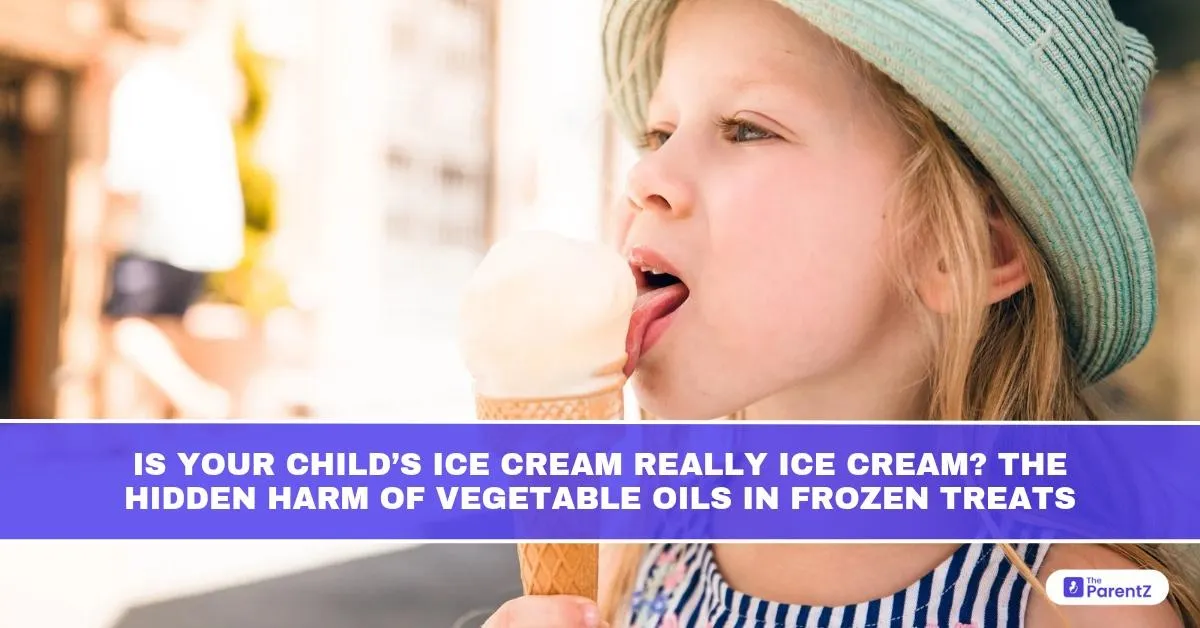The Cool Treat with a Hot Concern
It’s summer. Your child finishes their homework and runs to the freezer for a sweet reward. You think, “It’s just ice cream, a small treat.” But here’s the question: Is it really ice cream or something else entirely?
Many frozen treats sold across India are not dairy-based ice creams at all. They’re “frozen desserts,” made from vegetable oils, milk solids, sweeteners, and additives. And while they taste the same, the impact on a growing child’s health can be vastly different.
As a dental practitioner, I’ve often seen children with a strong preference for cold, creamy desserts, especially after meals or as rewards. But frequent consumption of oil-laden, sugar-rich frozen desserts shows up quickly on the teeth, the tongue, and sometimes in a child’s sluggishness or tummy complaints.
Frozen Dessert vs. Real Ice Cream: What’s the Difference?
According to FSSAI (Food Safety and Standards Authority of India):
- Ice Cream must be made with real milk fat (from milk or cream).
- Frozen Dessert is made using vegetable oils or fats (like palm kernel oil), along with sweeteners and emulsifiers.
These two may look, taste, and smell the same, but the body (especially a child’s body) processes them very differently.
Why Vegetable Oil-Based Ice Creams May Harm Children
1. Harder to Digest for Young Guts: Vegetable fats, especially palm or hydrogenated oils, are processed, dense, and not ideal for a child’s sensitive digestive system.
2. Stomach Issues: Some children complain of bloating, stomach aches, or even loose motions after consuming such desserts regularly.
3. No Natural Nutritional Value: Unlike milk-based ice creams that at least provide calcium and protein in small amounts, frozen desserts with oils offer empty calories, mostly fat and sugar. They do not support growth, bone strength, or brain development.
4. Promotes Unhealthy Fat Habits: Early exposure to high-fat, ultra-processed treats trains the child’s taste buds to seek out creamy, oily textures, which increases cravings for fried and junk food over time.
5. Dental Damage from Sticky Sugar and Cold: Most frozen desserts contain:
- High-fructose corn syrup or glucose syrups
- Artificial flavors
- Acidic additives
These combine to:
- Erode enamel
- Increase sensitivity
- Stick to molars and gaps: Children who suck or chew on ice cream slowly are at higher risk of caries, especially if they don’t rinse or brush soon after.
- Confusing Labels Mislead Parents: Many brands use large “Ice Cream” text, with the real category (frozen dessert) printed in small font. Even health-conscious parents may miss this crucial distinction.
What About Real Milk Ice Creams?
Genuine milk-based ice creams are not “healthy,” but they are less harmful when consumed occasionally.
Milk fat offers:
- Some calcium and phosphorus good for teeth
- Small doses of protein and vitamin A
- No trans fats (unlike hydrogenated oils)
However, real ice cream is still high in sugar and must be treated as an occasional indulgence, not a daily food.
How to Read the Label: Quick Tips for Parents
- Look for “milk fat” in the ingredients, not “edible vegetable oil.”
- Check the fine print.
- Prefer brands that clearly mention.
What I See in My Clinic
“Many children I treat for cavities or sensitivity have a visible pattern: daily cold treats, evening milkshakes, and frequent dessert rewards. When I ask what they eat, the parents say, ‘just ice cream once a day.’ But when we check the wrapper, it’s not ice cream, it’s a vegetable oil-based dessert.”
These oils leave sticky coatings on the tongue and teeth, especially around the back molars and upper grooves, areas that young children rarely clean well.
They also reduce the self-cleansing ability of saliva, increasing the chances of food debris and plaque staying on surfaces longer.
Smart Alternatives for Chilled Cravings
Not all cold treats are off-limits. Try these instead:
- Homemade frozen yogurt with real curd and fruits
- Milk-based kulfi (without added color or syrups)
- Fruit popsicles made at home with fresh juice and no sugar
- Chilled banana smoothies with peanut butter (calcium + protein rich)
These support oral health, give real nutrients, and can still satisfy your child’s love for something cold and sweet.
Final Word: Choose What Feeds, Not Just Fills
“As a dentist, I can treat cavities. But as a health educator, I’d rather prevent them by helping parents see what food really offers. If your child’s ice cream is full of oil and chemicals, it’s not a treat, it’s a trap.”
It’s not about denying kids fun, it’s about being informed. Choose products that nourish, not just numb the tongue.
Real ice cream, in moderation, can be enjoyed. But frozen desserts made with industrial oils? That’s not a harmless indulgence; it’s a daily habit with hidden harms.









Be the first one to comment on this story.